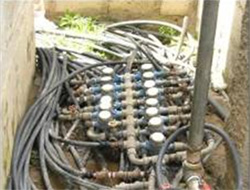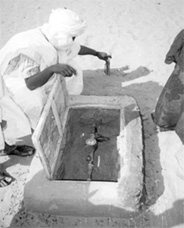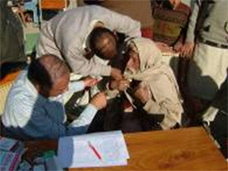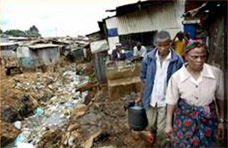1) What is involved ?
A pricing method that takes into account not only the volume of water consumed but also certain social or economic characteristics.
2) Who use this means and since when ?
Only a few cities and countries, especially in Latin America but also in Europe, such as Greece, Belgium and the United Kingdom, but only for a short period of time now
3) Why ?
It makes it possible to reduce the price of invoices for various categories that are generally unfavoured by conventional pricing systems based solely on the knowledge of the water consumption.
It is however a little more complicated to manage which is why it is not used very much
4) Who is primarily concerned ? Contexts in which this means seems best suited
These are the categories specified hereinabove and the locations where they are rather numerous while still able to be easily identified.
5) What does this process involve ? How is it used ?
This entails establishing rates comprising reductions for various categories that are disadvantaged either because of their low income, the high number of people in the household, the type of housing, and sometimes even the state of health, old age or widowhood…
This pricing method can be applied, subject to adaptation, to conventional purely linear or two-part pricing systems as well as to progressive pricing systems.

Multiple meters. PSEau photo 

Photo Burgeap
Several examples indicated further on show the diversity of solutions that can be considered. We shall see that the not-so-easy ways of identifying the underprivileged are carried out in various ways and in a more or less rigorous manner according to the country. As such, in Chile for example, the State uses pre existing social assistance files as a base, while in Columbia, the basis is information concerning the housing and the place of residence.
6) Main advantages and drawbacks
 a) Advantages
a) Advantages
- Makes it possible to offset the negative effects of the other pricing methods on the underprivileged and large families.
- Can allow parameters other than resources and the number of people in the same family to be taken into account.
- Provides more possibilities to set up significant reductions.
b) Disadvantages
- Management is a little more complicated, just in updating files for example.
- It is often difficult to precisely identify the people concerned, certain communities moreover are using rather approximate methods.
- Requires easy access to a minimum amount of reliable statistical data.
7) Achievement examples
a) In CHILE
The State decided to subsidise low-income users who are part of the 10% with the lowest income so that they do not spend more than 5.5% of their resources for water although this percentage could reach up to 12%.
This reduction, set up via a law in June 2004 on the social protection of families in extremely poor conditions, concerns according to the situations, from 25 to 85% of the volume billed but there is a ceiling of 15 m3/month/subscription, with the 225,000 poorest families benefitting free of charge from the first 15 m3. This is practiced by the water department and is reimbursed by the State.
For this, the State refers to the results of the four-yearly national surveys on the basis of which family assistance, supplemental retirement pensions or housing assistance are allocated.
Extracts from the UNDP Report from 2006 on the more precise conditions of this pricing.
Water provision in Chile is privatized under a strong regulatory regime that combines high levels of efficiency in provision with equally high levels of equity in access. Many factors have contributed. Initial advantages included near-universal coverage before privatization and a highly developed network. Strong economic growth has also been important. So too have targeted water subsidies.
Chile introduced means-tested water consumption subsidies in the early 1990s to guarantee affordability for low-income households. The subsidy covers 25%– 85% of a household’s monthly bill for up to 15 cubic metres of water a month. The government reimburses the company on the basis of the actual amount of water consumed. The subsidy is financed entirely from the central government budget. Households have to apply for the subsidy to the municipality, which determines eligibility. The subsidy can be thought of as an increasing block tariff, with subsidies inversely related to household income : support declines as incomes rise above the means-tested minimum threshold.
In 1998 about 13% of Chilean households—nearly 450,000 people—received subsidies at a cost of $33.6 million. The scheme has made it possible to increase tariffs, mobilize resources for maintenance and network expansion and minimize adverse effects on poor people.
There are two basic ingredients for the success of this model in Chile. Neither of them is easy to replicate in other developing countries. First, the scheme requires a capacity to identify, target and deliver support to low-income households. Second, every household must have a meter for monitoring water use..
Sources : Alegría Calvo and Celedón Cariola 2004 ; Gómez-Lobo and Contreras 2003 ; Pare¬des 2001 ; Serra 2000.
b) In BRAZIL
- In BELO HORIZONTE, the city grants a tariff reduction with a ceiling at 15 m3/month to inhabitants of modest housing.
Example : on a rate slightly above one euro/m3, the city grants a reduction to those who live in a housing unit with a surface area less than 45 m2 if they consume less than 15 m3.
- In MANAUS, a reduction of 75% is applied to the poorest houses (about 2.5% of the population).
c) In COLUMBIA
Columbia is one of the countries where the proportion of the price of water in relation to income can reach for the poor the highest level (13%). Several cities have established tariffs often comprising many brackets and which take into account the financial situation of users according to method that is often rather particular.
Reductions that vary, according to the communities, from 15 to 50% of consumption with a ceiling of 20 or 40% and offset by increases for other users from 15 to 30%, are as such granted to large underprivileged families simply according to their residential area defined by the public powers by and by the type of section of town. Balancing grants are also paid by the State.
d) Others countries
In BELGIUM (in Brussels and in Flanders), in SPAIN (in particular in Madrid, Barcelona, Murcia and Seville), in MALTA, in GREECE (such as in Athens and Salonika), in HUNGARY…several communities take account in their pricing of the size of large underprivileged families.
In FRANCE, there is a very good and new example of a such kind of tariff in DUNKERQUE area where a new tariff has been settled (October 2012) and includes a special price for the 8600 poorest families (10% of the population): 0,32 €/m3 for the first 75 m3 instead of 0,83 €/m3 for others and 70% minus that the previous tariff (1,01 €/m3). Numerous families receive a grant of 12 €/year for each member after the fifth.
See Fact sheet B3 (5b-examples) for more detais.
e) Finally
In several other countries such as Panama, Venezuela, India or Nicaragua, rates for water in the shantytowns are lower
 8) Where to obtain further information
8) Where to obtain further information
UNDP : "World Human Development Report 2006". This long and very interesting Report, also available in French, contains a wealth of information and figures on issues with water and sanitation in the world, and in particular (pages 80 to 100) on the situation of the poorest and on issues with pricing and assistance (pages 84 to 86 and 97 to 99). In particular, it gives the example of the socio-economic pricing of Chile on page 98.
http://hdr.undp.org/en/media/HDR_20...














